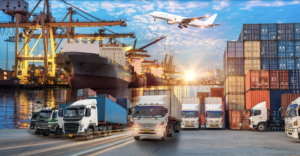12 Jan Asia – A hub for logistics
Asia – A hub for logistics | Just as we observe in other industries the COVID-19 pandemic has transformed global logistics in profound ways. However, unique to the logistics and supply chain industry is that, the decline in economic activity during the pandemic has not negatively affected the global logistics too significantly. Experts still note that the purchase of goods—therefore requiring the corresponding logistics needs—is not too affected.
In this overview, NAOS International outlines the key trends and observations for the Logistics and Supply Chain industry that would shape the outlook and performance for 2022.
It is clearly noted that the market is becoming more dynamic, with many new start-ups increasing the competition intensity in the industry. That being said, established players have also consolidated and participated in M&A activities to scale up their operations and maintain their standing in the market.

NAOS International – Logistics in Asia
Asia as a growing hotspot for the Logistics industry
Particularly for the Asia market, NAOS International sees strong indicator suggesting Asia’s recovery from COVID-19 will likely outpace the other regions in 2022. Experts foresee that Asia is likely to account for 57% in growth of the global e-commerce logistics market leading to 2025.
Analysts project that many Asian countries will recover faster economically and have a strong performance on their GDP levels. On average, GDP growth in Asia is forecasted at 4.5% – that is more than twice the average growth expected in GDP for the world. In fact, by 2030, it is likely that 30% of world consumption is be in Asia itself.
Within Asia, China, Japan and India continue to maintain their positions as the largest markets for logistics with Indonesia, Vietnam, Thailand and Malaysia showing strong growth potential too.
China, India and Indonesia led as the world’s top emerging markets under a Emerging Markets Logistics Index – This is an index that measures competitiveness based on logistics strength and business fundamentals.
According to The Edge Markets, the Index ranks 50 countries based on factors that make them attractive to logistics providers, air cargo carriers, freight forwarders, distributors and shipping lines.
Among ASEAN countries, Indonesia holds the 3rd ranking, followed by Malaysia at 5th rank and Vietnam climbing three spots to number 8 overall.
Early 2020 indicated supply disruptions particularly in China prompting leaders to consider if this would result in an exodus of manufacturing by multi-nationals looking to diversify sourcing and production.
According to the 1,200 responses received on the survey index, NAOS International notes a few key sentiments in the market:
- Despite the disruptions experienced in the China market, there is minimal serious thoughts to uproot from China or other markets, where executives prefer to protect their supply chains by accelerating adoption of digital tools and technology instead (41.3%) in contrast to pursuing multi-shoring, near-shoring or reshoring strategies (21.9%).
- Leader who do consider shifting bases out of China then look at Vietnam as the next preferred production hub than any other Asian countries (19.6%). Following Vietnam, other markets considered are – India (17.4%), Indonesia (12.4%), Thailand (10.3%).
- Only 7.8% of industry executives say moving production out of China would just result in simply moving production back to their own home countries.
It is good to note that attention is drawn to other Asian countries like India, Indonesia, Malaysia, Thailand and Vietnam primarily because these markets have been and are continuing to improve their supply chain infrastructure and capabilities, demonstrating why they are seen as strong alternatives.
While we have observed competition intensifying rapidly in this space, it is important to note that there are still opportunities worth grabbing. As an Executive Search firm, NAOS International has seen steady interest in companies looking to build and expand their presence in Asia with the recruitment of top talents to lead that growth.
In 2021, NAOS International observed that M&A and start-ups attracted about $25 billion USD in Q1 of 2021 in Asia – that already broke records of annual figures from 2016 to 2019.
Such growth in this short period means that fast growing companies from US and Europe region in Logistics are actively looking to enter the Asian Market to capitalize and improve their standing. This often leads to the hiring and recruitment of a team of leaders in Asia who would be instrumental and armed with knowledge of the Asian market to lead such growth.
It is clear to experts – The numbers and trends makes a strong case that Asia could be the single most important hub for global logistics trade and activities in the coming decade. Leaders and companies part of this ecosystem should recognize this as a window of opportunity that should be acted on quickly as a means to build their competitive advantage and cement their foothold as a competitor in the industry.
Apart from losing competitive egde, not considering Asia would also result in companies not being nearly as effective and relevant in fulfilling the demands of the customers globally especially with Asia being a key part of the supply chain ecosystem.
The future of the logistics industry looks buoyant, given the phenomenal rise of eCommerce and the increasing trend of online shopping. The aftermath of COVID-19 has also been instrumental to fuel the growth of logistics and supply chain – NAOS International observes this reflecting with the strong hiring interest in logistics in Asia.
—
To learn about DeFi Consulting Group (DCG) – our consulting firm focusing on digital assets and decentralized finance advisory – please click here.
Read more about the growth in Asia through our article here.